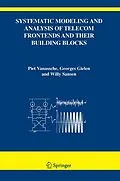To meet the demands of today's highly competitive market, analog electronics designers must develop their IC designs in a minimum of time. The difference between first- and second-time right seriously affects a company's share of the market. Analog designers are therefore in need for structured design methods together with the theory and tools to support them, especially when pushing the performance limits in high-performance designs. Systematic Modeling and Analysis of Telecom Frontends and Their Building Blocks aims to help designers in speeding up telecommunication frontend design by offering an in-depth understanding of the frontend's behavior together with methods and algorithms that support designers in bringing this understanding to practice. The book treats topics such as time-varying phase-locked loop stability, noise in mixing circuits, oscillator injection locking, oscillator phase noise behavior, harmonic oscillator dynamics and many more. In doing so, it always starts from a theoretical foundation that is both rigorous and general. Phase-locked loop and mixer analysis, for example, are grounded upon a general framework for time-varying small-signal analysis. Likewise, analysis of harmonic oscillator transient behavior and oscillator phase noise analysis are treated as particular applications of a general framework for oscillator perturbation analysis. In order to make the book as easy to read as possible, all theory is always accompanied by numerous examples and easy-to-catch intuitive explanations. As such, the book is suited for both computer-aided design engineers looking for general theories and methods, either as background material or for practical implementation in tools, as well as for practicing circuit designers looking for help and insight in dealing with a particular application or a particular high-performance design problem. TOC:Foreword.- Contributing Authors.- Contents.- Symbols and Abbreviations.- 1. Introduction.- 2. Modeling and analysis of telecom frontends: basic concepts.- 3. A framework for frequency-domain analysis of linear periodically timevarying Systems.- 4. Applications of LPTV system analysis using harmonic transfer matrices.- 5. Modeling oscillator dynamic behavior.- 6. Conclusions.- A. HTM norms and the comparison of HTMs.- B. The Sherman-Morisson-Woodbury formula.- C. HTM elements of the linear downconversion mixer.- D. Oscillator dynamics: analysis of the deviation from the attracting manifold.- E. Analysis of a harmonic oscillator.- Bibliography.
Zusammenfassung
nalog circuits are fascinating artifacts. They manipulate signals whose informa- Ationcontentisrichcomparedtodigitalsignalsthatcarryminimalamountofinf- mation;theyaredelicateinthatanyperturbationduetoparasiticelements,todelays,to interactionswithotherelementsandwiththeenvironmentmaycauseasigni?cantloss ofinformation. Thedif?cultyindealingwiththeseartifactsistoprotectthemfromall possibleattacks, evenminorones, fromthephysicalworld. Theironyisthattheyare oftenusedtofunnelinformationfromandtothephysicalworldtoandfromtheabstr- tionofthedigitalworldandforthisfunction, theyareirreplaceable. Nowonderthen that analog designers form a club of extraordinary gentlemen where art (or magic?) ratherthanscienceisthesharedtrade. Theyaredif?culttotrainsinceexperienceand intuitionarethetraitsthat characterize them. Andthey have dif?cultiesinexplaining what is the process they use to reach satisfactory results. Tools used for design (s- ulation) are mainly replacing the test benches of an experimental lab. However, the growing complexity of the integrated systems being designed today together with the increasing fragility of analog components brought about by shrinking geometries and reducedpowerconsumptionisposingseverechallengestotraditionalanalogdesigners to produce satisfactory results in a short time. At the same time, the need for expe- enced analog designers has increased constantly since almost all designs, because of integration,docontainanalogcomponents. Thissituationhascreatedastronginterest in developing design methodologies and supporting tools that are based on rigorous, mathematically literate, approaches. Doing so will make it possible to leverage the expertiseofseasonedanalogdesignersandtotrainnewgenerationsfasterandbetter. Inthepast, severalattemptshavebeenmadeinacademia andindustrytocreatethese methodologies and to extend the set of tools available. They have had questionable acceptance in the analog design community. However, recently, a ?urry of start-ups andincreasedinvestmentbyEDAcompaniesinnoveltoolssignalasigni?cantchange inmarketattentiontotheanalogdomain. Ipersonallybelievethattosubstantially- prove quality and design time, tools are simply insuf?cient. A design methodology based on a hierarchy of abstraction layers, successive re?nement between two ad- cent layers, and extensive veri?cation at every layer is necessary. To do so, we need to build theories and models that have strong mathematical foundations. The analog design technology community is as strong as it has ever been.
Inhalt
Zusammenfassung
nalog circuits are fascinating artifacts. They manipulate signals whose informa- Ationcontentisrichcomparedtodigitalsignalsthatcarryminimalamountofinf- mation;theyaredelicateinthatanyperturbationduetoparasiticelements,todelays,to interactionswithotherelementsandwiththeenvironmentmaycauseasigni?cantloss ofinformation. Thedif?cultyindealingwiththeseartifactsistoprotectthemfromall possibleattacks, evenminorones, fromthephysicalworld. Theironyisthattheyare oftenusedtofunnelinformationfromandtothephysicalworldtoandfromtheabstr- tionofthedigitalworldandforthisfunction, theyareirreplaceable. Nowonderthen that analog designers form a club of extraordinary gentlemen where art (or magic?) ratherthanscienceisthesharedtrade. Theyaredif?culttotrainsinceexperienceand intuitionarethetraitsthat characterize them. Andthey have dif?cultiesinexplaining what is the process they use to reach satisfactory results. Tools used for design (s- ulation) are mainly replacing the test benches of an experimental lab. However, the growing complexity of the integrated systems being designed today together with the increasing fragility of analog components brought about by shrinking geometries and reducedpowerconsumptionisposingseverechallengestotraditionalanalogdesigners to produce satisfactory results in a short time. At the same time, the need for expe- enced analog designers has increased constantly since almost all designs, because of integration,docontainanalogcomponents. Thissituationhascreatedastronginterest in developing design methodologies and supporting tools that are based on rigorous, mathematically literate, approaches. Doing so will make it possible to leverage the expertiseofseasonedanalogdesignersandtotrainnewgenerationsfasterandbetter. Inthepast, severalattemptshavebeenmadeinacademia andindustrytocreatethese methodologies and to extend the set of tools available. They have had questionable acceptance in the analog design community. However, recently, a ?urry of start-ups andincreasedinvestmentbyEDAcompaniesinnoveltoolssignalasigni?cantchange inmarketattentiontotheanalogdomain. Ipersonallybelievethattosubstantially- prove quality and design time, tools are simply insuf?cient. A design methodology based on a hierarchy of abstraction layers, successive re?nement between two ad- cent layers, and extensive veri?cation at every layer is necessary. To do so, we need to build theories and models that have strong mathematical foundations. The analog design technology community is as strong as it has ever been.
Inhalt
Foreword.- Contributing Authors.- Contents.- Symbols and Abbreviations.- 1. Introduction.- 2. Modeling and analysis of telecom frontends: basic concepts.- 3. A framework for frequency-domain analysis of linear periodically timevarying Systems.- 4. Applications of LPTV system analysis using harmonic transfer matrices.- 5. Modeling oscillator dynamic behavior.- 6. Conclusions.- A. HTM norms and the comparison of HTMs.- B. The Sherman-Morisson-Woodbury formula.- C. HTM elements of the linear downconversion mixer.- D. Oscillator dynamics: analysis of the deviation from the attracting manifold.- E. Analysis of a harmonic oscillator.- Bibliography.
Titel
Systematic Modeling and Analysis of Telecom Frontends and their Building Blocks
EAN
9781402031748
ISBN
978-1-4020-3174-8
Format
E-Book (pdf)
Hersteller
Herausgeber
Veröffentlichung
24.10.2005
Digitaler Kopierschutz
Wasserzeichen
Dateigrösse
10 MB
Anzahl Seiten
230
Jahr
2006
Untertitel
Englisch
Unerwartete Verzögerung
Ups, ein Fehler ist aufgetreten. Bitte versuchen Sie es später noch einmal.
